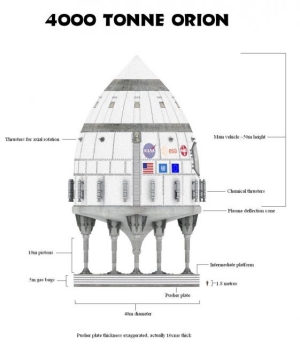Centauri Dreams
Imagining and Planning Interstellar Exploration
Assessing the Asteroid Factor
I’ve always thought that the biggest driver for our next steps in space is the presence of asteroids. Asteroids affect us in two powerful ways, the first being that they are sources of potential wealth for companies like Deep Space Industries and Planetary Resources, as commercial operations use robotics and eventually humans to extract water and precious metals. Likewise significant is that near-Earth asteroids are a reminder that developing the tools for altering an asteroid trajectory is a good insurance policy for planetary protection.
Asteroids go past us all the time. I count eight that will move past the Earth between now and October 1, the closest — 2015 SO2 and 2015 DS53 — moving within 17 lunar distances. There’s nothing to worry about in this list, as all have zero chance of impacting the Earth. Looking ahead to the first 20 days of October, the closest pass will be by asteroid 462959, at 15 lunar distances. A lunar distance is 384,401 kilometers, and it’s how the Minor Planet Center tabulates these things. I’m also using the MPC’s assessment of impact risks.
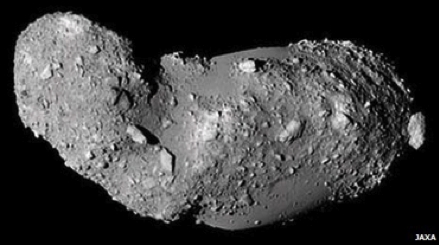
Image: The Near-Earth asteroid Itokawa, from which the Japanese Space Agency (JAXA) returned samples in its Hayabusa mission. Credit: JAXA.
Asteroid impacts make for sensational speculation and the occasional overwrought movie, but I’d suggest the best approach to them is simple prudence. We have a mission — OSIRIS REx — on its way to an asteroid called Bennu to make numerous scientific investigations, teaching us about the early history of the Solar System. But the mission will also help us understand the factors that influence an asteroid’s trajectory, such as the Yarkovsky effect, which can slightly alter a small object’s movement because of the uneven heating it can experience. Learning more about such factors suggest better ways to nudge any errant asteroid in the future.
What I really favor is simply keeping asteroids in focus and educating the public about what we’re learning, so that we can get past the sensationalism and make better choices about future missions. It’s useful on that score to point to the Minor Planet Center’s Asteroid Data Explorer site, which allows viewers to quickly drill down into the actual data. If you want to rank asteroids by size, orbital period or closest approach, you can quickly summon up the needed information, with adjustable filters in place for fine-tuning. You can also rank nearby objects in terms of their potential for impact, invariably slight, but a number we always want to keep refining.
Enter ‘The Daily Minor Planet’
Operating at the Smithsonian Astrophysical Observatory, the Minor Planet Center tracks not just near-Earth objects but also comets and the outer satellites of the major planets. As to the term ‘minor planet’ itself, it refers to objects orbiting the Sun that are neither planets nor comets, which can be anything from a dwarf planet like Pluto to a Kuiper Belt Object or an asteroid, trojan or centaur. These turn up more quickly than I would have suspected, with the MPC listing 477 such objects discovered just this month. 45 Near-Earth Objects turned up in the same period, with 1244 NEOs discovered so far in 2016.
2015 DS53, a Near-Earth Object, passes within those 17 lunar distances I mentioned above in the early morning UTC on September 22. The list of close approaches maintained on the MPC site is a fascinating thing to track, reminding us how much our view of the Solar System has changed in the past half century. Few people in the 1950s would have imagined such a debris-laden system, with another belt of material outside the most distant known planet, and a vast halo of comets beyond that. And few would have thought there were so many NEOs.
As the Minor Planet Center reminds us, a known asteroid passes within a few million miles of our planet just about every day. And it has just introduced yet another way of tracking these through an online service called the Daily Minor Planet, which is being developed both by the MPC and volunteers from Oracle Corporation. Asteroid updates go straight to your inbox. Astronomer Matt Holman, director of the MPC, sees the project as an educational resource:
“Most people don’t realize how common asteroid flybys are. We want the Daily Minor Planet to educate readers in an entertaining way, so the next time they see a doom-and-gloom asteroid headline, they’ll know where to go to find the facts.”
This is an outreach project worth keeping an eye on. You can subscribe here. And I think Holman has it right when he refers to ‘asteroid headlines.’ The facts invariably knock the pins out from under the sensationalists who try to milk every natural phenomenon for controversy, but having a widely distributed fact-checking source like this one should tamp all that down.
What we need about asteroids is information and careful analysis. If some entrepreneurs are right, they’re going to play a large role in creating new wealth one day, and if I’m right, they’re going to act as a spur to help us develop the needed technologies to reach them quickly. What we learn will inevitably pay dividends in case we do discover a serious threat, which is why asteroids and their potential should play a major role in an informed space policy.

A Rapidly Disintegrating Comet
Comet 332P/Ikeya-Murakami has had a short but colorful history in our observations. First detected in 2010 by two amateur astronomers in Japan, the comet has been spinning off debris at least since 2015 and probably earlier. A large fragment, as big as Comet 332P itself, may have broken off in 2012. Still close to the comet, its discovery prompted a team led by David Jewitt (UCLA) to request time on the Hubble Space Telescope to study what was happening.
Among a long page of posted quotations on Jewitt’s UCLA website is this by Erwin Schrodinger: “The task is, not so much to see what no one has yet seen; but to think what nobody has yet thought, about that which everybody sees.” In this case, what everybody now sees is our most in-depth look at a comet’s disintegration ever. The trick is what to make of what we see.
The Hubble observations, taken in early 2016, show us 25 separate fragments, mixtures of dust and ice that are slowly separating from the comet at no more than the pace I make on my morning walk. The fragments make up about four percent of the parent comet, ranging in size from 20 meters to 60 meters. Comet 332P completes a rotation every two to four hours, and it’s thought that the fragments may be thrown from the surface by this spin, leaving them to fan out along a trail fully 4800 kilometers long.
Another quote Jewitt references on his web page comes from Heraclitus: “If you do not expect the unexpected, you will not find it; for it is hard to be sought out, and difficult.” A comet’s gradual death as it approaches the Sun would not be considered unexpected, but in this case what has to be sought out is the process. It turns out to be far from gentle. Says Jewitt:
“In the past, astronomers thought that comets die when they are warmed by sunlight, causing their ices to simply vaporize away. But it’s starting to look like fragmentation may be more important. In comet 332P we may be seeing a comet fragmenting itself into oblivion.”
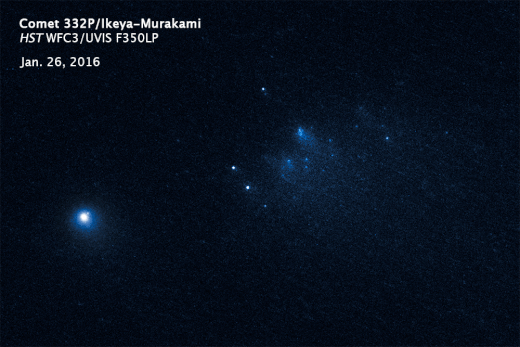
Image: This NASA Hubble Space Telescope image reveals the ancient comet 332P/Ikeya-Murakami disintegrating as it approaches the sun. The observations represent one of the sharpest views of an icy comet breaking apart. The comet debris consists of a cluster of building-size chunks near the center of the image. They form a 4800-kilometer-long trail, larger than the width of the continental U.S. The fragments are drifting away from the comet, dubbed comet 332P, at a leisurely pace, roughly the walking speed of an adult.. Credit: NASA, ESA, David Jewitt/UCLA.
This is a short period comet that when discovered was 1.6 AU out, its detection taking place one month after perihelion in October of 2010. It has evidently survived a roughly 10 million year journey to the inner system, and Jewitt and colleagues estimate that it contains enough mass for about 25 more outbursts. With an orbital period of less than six years, we may be looking at a very short-lived spectacle, in astronomical terms. As Jewitt says:
“If the comet has an episode every six years, the equivalent of one orbit around the sun, then it will be gone in 150 years. It’s just the blink of an eye, astronomically speaking. The trip to the inner solar system has doomed it.”
The Hubble images captured 332P/Ikeya-Murakami breaking up almost 110 million kilometers from Earth, as comet and its debris orbit the Sun at approximately 80,000 kilometers per hour. The comet turns out to be smaller than originally thought, measuring about 500 meters across. Its fast rotation is probably the result of sunlight heating the surface, causing it to expel jets of dust and gas. The material we see in the image was probably shed between October and December of 2015.
The paper is Jewitt et al., “Fragmentation Kinematics in Comet 332P/Ikeya-Murakami,” published online by Astrophysical Journal Letters 15 September 2016 (abstract / preprint). David Jewitt’s entertaining selection of quotes can be found here. I can’t resist adding one last quote because it’s a personal favorite from Yogi Berra: “In theory there is no difference between theory and practice. In practice there is.”

Puzzling Out Pluto’s X-Ray Emissions
The latest news from the Chandra X-Ray Observatory is that the spacecraft, 100 times more sensitive to X-ray sources than any previous X-ray telescope, has found that Pluto is emitting X-rays. This marks the first time we’ve detected X-rays from a Kuiper Belt object. In fact, until now, the previous most distant Solar System body with detected X-rays was Saturn. But four Chandra observing runs from early 2014 through the summer of 2015 have detected X-rays, in work on Pluto done in coordination with the the New Horizons effort.
Carey Lisse (JHU/APL) led the Chandra observing runs, working with New Horizons co-investigator Ralph McNutt (also at JHU/APL). Says Lisse:
“We’ve just detected, for the first time, X-rays coming from an object in our Kuiper Belt, and learned that Pluto is interacting with the solar wind in an unexpected and energetic fashion. We can expect other large Kuiper Belt objects to be doing the same.”
The New Horizons pass by Pluto/Charon in July of last year is a useful background to what Chandra has found. At first glance, Pluto would not seem to be a likely X-ray emitter. The dwarf planet lacks a magnetic field and has no evident mechanism for producing X-rays. But we’ve learned through studies of comets that the gases associated with Solar System objects can interact with the solar wind, the stream of charged particles flowing from the Sun, to produce X-rays.
Thus a comet, or a planet, can produce the material needed for the solar wind interaction to take place,. We know the mechanism is potent, because back in 1996, comet Hyakutake was shown to be producing X-rays in data from the German ROSAT observatory. It was a natural thought that Pluto, which was known to be venting atmosphere in some ways similar to a comet, could produce the same. At the Chandra site, Lisse and McNutt have written a useful essay on the recent detections. Here’s their take on interactions with the solar wind:
The way comets emit X-rays is not because they are hot and highly energetic, like all the other X-ray sources we know of in the sky like stars, black holes, neutron stars, and colliding shock waves. Instead comets are very cold, but they boil off gas from their ices when they approach the Sun — and that’s half of what is needed to make X-rays. The other half is the contribution of the biggest and hottest thing in our solar system: the Sun.
The Sun is a potent source indeed, and we’ve often looked at its solar wind from the perspective of potential spacecraft in various ‘magsail’ configurations. In terms of X-rays, the solar wind creates complicated effects.
The Sun not only emits its own X-rays as it boils and seethes and twists magnetic fields on its incendiary surface, it also blows out a stream of high energy ionized plasma – a gas composed of free electrons and free atomic nuclei – from the million degree tenuous corona (or atmosphere) surrounding its surface. This stream, called the solar wind, contains highly charged ions of hydrogen, helium, carbon, nitrogen, oxygen, iron, magnesium, neon, and sulfur, to name the most abundant species. If one of these ions ever gets near another atom with all its electrons, it will rip one or two of them off, emitting X-ray photons in the process.
Thus possible interactions were on the minds of New Horizons mission planners from the beginning, which is why the craft carried its Solar Wind Around Pluto (SWAP) instrument, as well as PEPPSI (the Pluto Energetic Particle Spectrometer Investigation), designed to pick up such activity. The ALICE UV spectrometer was also aboard to examine the rate of atmospheric loss into space, which would give a read on the material available for such interactions.
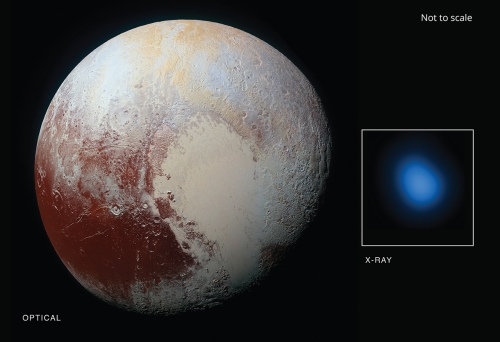
Image: The main panel in this graphic is an optical image taken from New Horizons on its approach to Pluto, while the inset shows an image of Pluto in X-rays from Chandra. There is a significant difference in scale between the optical and X-ray images. New Horizons made a close flyby of Pluto but Chandra is located near the Earth, so the level of detail visible in the two images is very different. The Chandra image is 290,000 kilometers across at the distance of Pluto, but the planet is only 2400 kilometers across. Pluto is detected in the X-ray image as a point source, showing the sharpest level of detail available for Chandra or any other X-ray observatory. This means that details over scales that are smaller than the X-ray source cannot be seen here. Credit: JHU/APL; Chandra X-Ray Observatory.
The surprise in this work is not so much that we have found X-rays in the first place, but that our models for solar wind intensity at Pluto’s distance don’t work out as neatly as they might. Pluto, New Horizons discovered, is releasing enough atmosphere to produce the X-rays, but they shouldn’t be emitted at this level of intensity given the amount of solar wind that actually reaches the dwarf planet. In fact, the New Horizons measurements peg the solar wind flux at too low by a factor of 40 to produce interactions as energetic as those the X-ray observations reveal.
We are left with an assortment of possibilities to explain why the X-ray intensity is as high as it is. Pluto may, for example, produce a larger gas ‘tail’ than what New Horizons detected with SWAP, a tail that would not necessarily be detected by Chandra at X-ray wavelengths. This is the prime candidate, and the conclusion that Lisse and McNutt favor, describing it thus:
It likely means that Pluto significantly perturbed the solar wind, and causes it to wrap around itself and focus into a long downstream tail, where it mixes with Pluto’s escaping atmosphere and makes X-rays. In fact, the New Horizons SWAP instrument has said just that, that they have detected a tail leading away from Pluto that contains ~1024 CH4 (methane) molecules per second getting ionized, which is consistent with what we need to create the X-rays detected by Chandra. They also figure that this tail extends at least 100 times the radius of the planet.
But there are other possibilities, as this Chandra news release makes clear. Interplanetary magnetic fields may be concentrating more solar wind particles than expected into the regions near Pluto. Also in the mix is the possibility that a torus of neutral gas could form, centered on Pluto’s orbit, thanks to the low density of the solar wind in the outer system. Chandra can’t make the distinction between these alternatives, which points to the need for higher resolution images of Pluto’s X-ray emissions to settle the matter.
The paper is Lisse et al., “The puzzling detection of x-rays from Pluto by Chandra,” in press at Icarus (abstract). Also pertinent is Bagenal et al., “Pluto’s interaction with its space environment: Solar Wind, Energetic Particles & Dust,” Science Vol. 351, Issue 6279 (abstract).

Project Orion: A Nuclear Bomb and Rocket – All in One
Larry Klaes has been a part of Centauri Dreams almost since the first post. That takes us back to 2004, and while I didn’t have comments enabled on the site for the first year or so, I remember talking to Larry about my Centauri Dreams book by email. Ever since, this author and freelance journalist with a passion for spaceflight has contributed articles, comments and ideas, as he does again today. Project Orion caught Larry’s attention as a way of using known technologies to enable daring deep space missions. The essay below gives us an overview of Orion and its possibilities, looking at a concept that never flew but still captures the imagination. In addition to his active freelancing, Larry has been editor of SETIQuest magazine and president of the Boston chapter of the National Space Society. He now writes regularly for SpaceFlight Insider, where this article originally appeared.
by Larry Klaes

Image: Project Orion concept. Image Credit: Adrian Mann.
At their most fundamental level, all rockets past and present were and are, basically, controlled bombs. Their fuel consists of materials and chemicals which, when activated/combined in the proper sequence and amount, create a series of explosive reactions. The resulting energy release is then directed in a manner so that the resulting exhaust comes out of the end of the rocket away from the payload sitting atop it and the direction that its builders want to send that payload. That is essentially Sir Isaac Newton’s third law of motion put into practice.
When this technological setup works, we have a successful mission. However, when something goes awry, we end up with a vehicle that can go from a powerful and fast means of space transportation to an inadvertently dangerous weapon. As just one large example, if the famous Saturn V rocket – which sent humans to the Moon for Project Apollo between 1968 and 1972 – had ever exploded, the 6.5-million-pound (2,950 metric tons) fully fueled booster would have created a destructive event equivalent to the detonation of a small nuclear bomb, minus the radiation. Thus the reason that no one (excluding the three mission astronauts, of course) was ever allowed within three miles (4.8 kilometers) of the launch pad at Cape Kennedy when a Saturn V was lifting off into space.
Image: Artist’s rendition of NASA’s Project Orion. Credit: NASA.
The former Soviet Union had several real world examples of just such a catastrophe with their equivalent N1 rocket, which they were using to compete with the United States in the race to place a man on the Moon by 1970. Every one of their N1 tests (all unmanned) ended in dramatic failure, with one rocket explosion on the ground practically vaporizing its launch pad and heavily cratering another pad with debris half a mile (almost one kilometer) away.
So now imagine a rocket design where the fuel used were actual bombs detonated on purpose – and nuclear bombs at that. It was known as Project Orion.
Not surprisingly, Orion was born during the Cold War, when the United States and the Soviet Union were squaring off against each other by stockpiling nuclear weapons to let each other know that an attack by one nation using such devices would be fatal for the other, along with most other places on Earth. This concept was called Mutually Assured Destruction, or MAD for short.
In the United States, the power of the atom was also being sold as a way to make life better for everyone. Nuclear power plants were being touted as a cleaner and much more efficient way to generate electricity for our civilization. The binding force of the atom was even seriously considered as a replacement for the fossil fuels powering our land, sea, and air vehicles.
The Ford Motor Company went so far as to come up with a car they called the Ford Nucleon, where a single nuclear fuel rod would keep this automobile of the future operating for over five thousand miles before a new fuel rod was required. The Ford Nucleon never got past the model stages, but the point is that a major American car company took the idea seriously, at least for a while.
Image (click to enlarge). Credit: Rhys Taylor.
If nuclear power could be plausibly applied to mere ground transportation, then using it to send heavy space vessels into the “final frontier” only made even more sense at the dawn of the Space Age. Both superpowers were cranking out those very methods of propulsion at an ever-increasing rate.
In an example of turning swords into plowshares, Project Orion was envisioned as a vessel carrying a supply of hydrogen bombs to be ejected out the stern of the spaceship one at a time. The bomb would then be detonated mere seconds later, where the resulting plasma would encounter a large, thick, shock-absorbing “pusher plate” attached to the end of the spaceship that would simultaneously allow Orion to be moved forward while protecting the ship from the blast and radiation. Each new bomb detonation that followed would push the vessel faster and faster, allowing Orion to reach just about anywhere in the Solar System within one year or the nearest star system, Alpha Centauri, in just over one century under one mission scenario.
Project Orion was worked on under a contract by the United States Air Force (USAF) at the General Atomics company from 1958 to 1965. Project models for Orion soon matched and exceeded the grand space dreams of the era due to its novel method of propulsion.
One team member, the famous Freeman J. Dyson of the Institute for Advanced Study in Princeton, New Jersey, envisioned a ship with a total mass of 400,000 metric tons (881,849,049 pounds) of which three-quarters of that weight would consist of 300,000 one-megaton H-bombs weighing 1,000 kilograms (2,205 pounds) each. The rest of the weight would be split between the payload and ship structure and the ablation shield. Detonating the bombs every three seconds (until the supply ran out in ten days under this scenario) would keep the acceleration at a comfortable 1 g, or gravity.
Image (click to enlarge): General Atomics Orion spaceship concept. Credit: William Black.
The plans for Orion were anything but timid. Manned Mars missions using this vessel would have been sent in 1965, followed by a mission to the ringed planet Saturn in 1970! The spaceship in the film 2001: A Space Odyssey, the USS Discovery, was originally designed as an Orion type craft aimed at Saturn in the novel version. The author of the film’s screenplay and novel, Arthur C. Clarke, was also a member of Project Orion. Not only could Orion have conducted a round-trip voyage to Pluto in just one year, but Dyson also calculated a version that could flyby Alpha Centauri in about 130 years at 3% light speed. By comparison, the Voyager space probes will take 77,000 years to reach the distance of our celestial neighbor 4.3 light-years away. The team even considered a massive Orion that could serve as an interstellar ark, which became the vehicle of choice in the 2014 television mini-series Ascension.
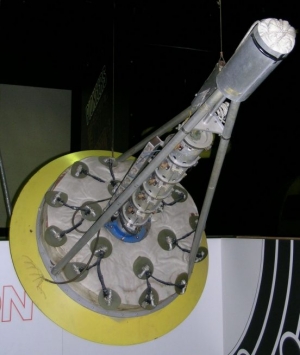
As a further reflection of the era, Project Orion was more than just a paper dream. The team built a working 7-foot (2.1-meter) scale model (non-nuclear of course) they called Hot Rod. Launched in 1959 at Point Loma, California, Hot Rod survived five successive explosions that struck its pusher plate and sent the vehicle faster and higher with each detonation. The test vehicle then parachuted safely to the ground, proving that Orion was as least technically feasible. Gulf General Atomic later donated Hot Rod to the Smithsonian in 1972, where it was long on display at the institution’s Air and Space Museum but is currently in storage. However, a scale model of the completed Orion vessel is publicly viewable at the Steven F. Udvar-Hazy Center in Chantilly, Virginia, in their Rockets and Missiles exhibition. This model was donated to the Smithsonian in 1979 by the General Dynamics Corporation.
Image: Project Orion ‘Hot Rod’ Propulsion Test Vehicle. Credit: Smithsonian National Air and Space Museum.
In the end, Orion was terminated neither by physics nor technology but by politics and a growing public fear of nuclear power. The Partial Nuclear Test Ban Treaty signed in 1963 forbids testing nuclear devices of any kind everywhere but underground. Two years later, the USAF canceled the project’s budget. Orion became a legendary symbol of an era known for both its far-reaching dreams and excesses of power. To this day, Orion is still the only feasible mean of interstellar travel, both robotic and manned, that could actually be built with current technology and knowledge.
So could (and would) Orion be revived some day? While the United States and Europe (via the European Space Agency) could make the vessel a reality, Orion’s very means of propulsion remain among the major hindrances to such a plan for the foreseeable future. At present, the greatest chance for Orion lies with China. They not only have the means and the resources to undertake such a grand project (as well as vast, remote regions where they could safely test and launch the vessel), but Orion would be a logical extension of their current strivings for major science and technology goals. This author notes that he has no actual knowledge if China has ever conducted or will ever conduct such a project, only that of all the spacefaring nations on Earth, they make for the most realistic choice at present for reviving Orion.
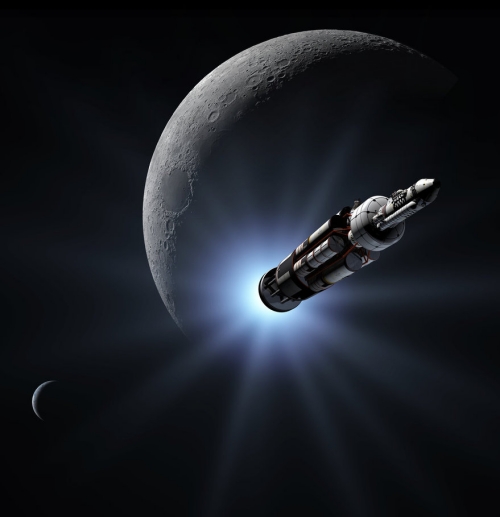
Image: Orion in flight. Credit: William Black.
Russia is another possibility for building Orion on a similar scale as China, but their current geopolitical issues make such prospects questionable on multiple levels. India might also be a contender for their own Orion down the road, but such a future remains to be seen. There are several other nations which have both their own space and nuclear programs, but the thought of them building an Orion in the near future is both questionable and concerning.
As Project Orion has always been about big dreams with even bigger goals, then perhaps we can one day hope that Orion will not only become a method for turning nuclear weapons away from Earth and our species and aim them toward the stars for peaceful purposes, but also that Orion might become a way that we can explore and colonize space together as one humanity.
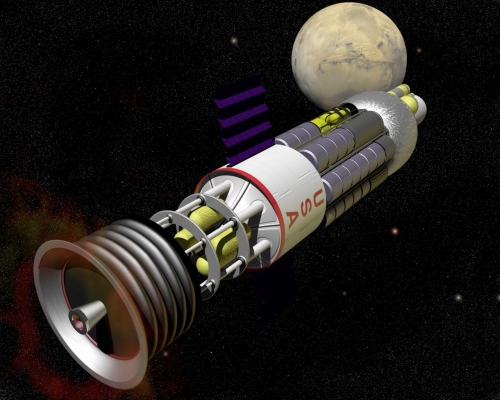
Image: Project Orion to Mars. Credit: NASA.
For more information on Project Orion, see the following:
Project Orion: The True Story of the Atomic Spaceship, by George Dyson, An Owl Book, Henry Holt and Company, New York, 2003.
These documentary videos on Project Orion here and here, and George Dyson TED Talk here.
For those want even more information about Project Orion and its variants, you must see Atomic Rocket’s pages on it here.
More links to updated information on Project Orion:
http://www.nextbigfuture.com/2016/01/orion-thunderwell-and-nuclear-space.html
http://www.nextbigfuture.com/2014/01/winterberg-reinvents-project-orion.html
http://www.nextbigfuture.com/2009/02/updated-project-orion-nuclear-pulse.html

Looking at Gaia’s Sky
The European Space Agency’s Gaia satellite has delivered a catalog of more than a billion stars — 1142 million, to be more specific — as it continues the work of mapping our galaxy in three dimensions. To be sure, we can expect much more from Gaia, but the September 14 data release is a milestone, offering distances and proper motion for more than 2 million stars. The mission’s first public release collects 14 months of data, from July 2014 to September 2015.
“The beautiful map we are publishing today shows the density of stars measured by Gaia across the entire sky, and confirms that it collected superb data during its first year of operations,” says Timo Prusti, Gaia project scientist at ESA.
To get an idea of Gaia’s long-term promise, recall that we are looking at the galaxy with Hubble-like precision. We may have more than a billion stars in today’s release, but 400 million of these are appearing in a catalog for the first time.
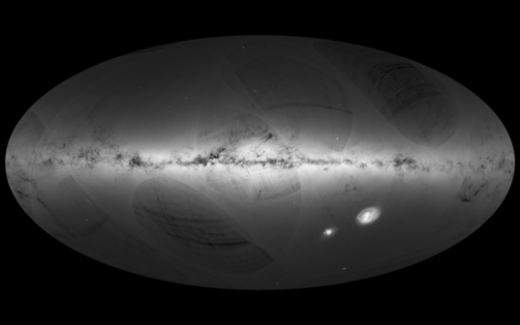
Image: An all-sky view of stars in our Galaxy – the Milky Way – and neighbouring galaxies, based on the first year of observations from ESA’s Gaia satellite, from July 2014 to September 2015. This map shows the density of stars observed by Gaia in each portion of the sky. Brighter regions indicate denser concentrations of stars, while darker regions correspond to patches of the sky where fewer stars are observed. The Milky Way is a spiral galaxy, with most of its stars residing in a disc about 100 000 light-years across and about 1000 light-years thick. This structure is visible in the sky as the Galactic Plane – the brightest portion of this image -which runs horizontally and is especially bright at the centre. Darker regions across the Galactic Plane correspond to dense clouds of interstellar gas and dust that absorb starlight along the line of sight. Many globular and open clusters – groupings of stars held together by their mutual gravity – are also sprinkled across the image. Credit: ESA.
The image is downloadable in a variety of file sizes. Fifteen scientific papers describing the Gaia data are to appear in a special issue of Astronomy & Astrophysics. Those interested in digging into Gaia’s first data release can gain access here.
A collaboration of 450 scientists and software engineers known as the Gaia Data Processing and Analysis Consortium (DPAC) is charged with turning the satellite’s raw data into reliable stellar positions. ESA explains just how much of an upgrade Gaia represents in this news release, which discusses not only the billion-star catalog, but the two million stars represented both in Gaia’s work and the earlier Hipparcos catalogs, which are now more than two decades old. Combining the data allows scientists to sort out not just the physical movement of stars in the galaxy but also parallax effects caused by the star’s apparent position during a year-long Earth orbit of the Sun. A combined Tycho-Gaia Astrometric Solution is the result.
Antonella Vallenari (Istituto Nazionale di Astrofisica (INAF) and the Astronomical Observatory of Padua, Italy) comments on Gaia’s significance in the study of open star clusters. These are groups of young stars that were born roughly at the same time:
“With Hipparcos, we could only analyse the 3D structure and dynamics of stars in the Hyades, the nearest open cluster to the Sun, and measure distances for about 80 clusters up to 1600 light-years from us. But with Gaia’s first data, it is now possible to measure the distances and motions of stars in about 400 clusters up to 4800 light-years away. For the closest 14 open clusters, the new data reveal many stars surprisingly far from the centre of the parent cluster, likely escaping to populate other regions of the Galaxy.”
Firming up our knowledge of the positions and motions of stars is useful not only for our study of the Milky Way’s properties but also in exoplanet analysis and even work within our own system. July’s stellar occultation by Pluto, for example, offered a way to study the dwarf planet’s atmosphere, and early release of Gaia’s position for this star was crucial to monitoring the occultation in the narrow strip of Earth’s surface that experienced it.
I also note Emily Lakdawalla’s comment on the use of Gaia data in the extended New Horizons mission. The target Kuiper Belt Object is one we need to know a great deal more about. Says Lakdawalla:
One very practical use of Gaia data in planetary exploration is for navigation by New Horizons to its Kuiper belt target, 2014 MU69. Because 2014 MU69 was discovered so recently, its orbit is not known to as high precision as they would like; Gaia can only help. The more precisely the New Horizons team can predict its future path, the more precisely they can point the spacecraft instruments at it — in some cases they may be able to save significantly on precious data volume by reducing the number of observations they have to do to be sure they get the little thing in their field of view. They may also be able to target the point of closest approach closer, which means we could get higher-resolution images of it — valuable because MU69 is expected to be quite small, only about 30 kilometers in diameter.
In terms of exoplanets, ESA predicts that Gaia will discover thousands of them using both astrometry (measuring stellar positions, motions and magnitudes) but also transit methods. We can look forward to further information about known planets around bright stars but also the confirmation of planets previously detected by radial velocity methods. ESA adds that astrometry should extend spectroscopic surveys to numerous nearby M-dwarfs as it complements ground-based observations.
Bear in mind that Gaia is a continuing mission that will, in its five year span, track its vast number of targets numerous times, allowing astronomers not only to pinpoint the locations of stars but analyze their movement in the galaxy. Detailed observations of Cepheid and RR Lyrae variable stars offer us vital clues about cosmic distances, readings that can be extended far beyond our own galaxy. The expansion and contraction of Cepheids is directly correlated to the star’s luminosity, making them valuable ‘standard candles’ for such measurements.
Gaia has, in the data released so far, discovered 386 new Cepheids in a census that now includes 3194 variable stars, many of which are found in the Large Magellanic Cloud. Gaia should be able to offer extremely accurate distance measurements to a large number of variable stars using parallax measurements, thus calibrating the known relationship between brightness and periodicity. This should prove invaluable in the study of distant galaxies. More accurate data will be included in a planned 2017 data release, which will also include positional data for perhaps a million galaxies. The mission runs until 2019, with a five year extension possible.
I like Jason Wright’s response to a tweet from @StarshipBuilder, reacting to the Gaia collaboration paper cited at the end of this post and asking “How many of the stars surveyed by Gaia will ever be visited by humans?”
Whoa, did @StarshipBuilder just editorialize?
Must be an exciting paper! :)
My answer: all of them, or none of them https://t.co/0t7AvaXyi0— Jason Wright (@Astro_Wright) September 15, 2016
All of them or none of them. What a thought!
625 authors are behind “The Gaia Mission,” accepted by Astronomy & Astrophysics (preprint) as part of its Gaia Special Feature.

On Charon’s Unusual North Pole
Deep space exploration brings a surprise with each new destination. New Horizons made the point over and over again, and today we get word of new work on one of the mission’s discoveries, that dark red polar cap at the north of Pluto’s large moon Charon. Will Grundy (Lowell Observatory) and colleagues are behind the study, which digs into the theory that methane from Pluto’s atmosphere is trapped at Charon’s north pole.
In a new paper in Nature, Grundy and team have used New Horizons mission data in conjunction with their own modeling of the evolution of Charon’s ice cap over the course of a Plutonian year to demonstrate that the model of trapped methane works. It involves the processing of methane into complex organic molecules called tholins. From the paper:
The distribution of dark, reddish material around Charon’s northern pole is notable for its generally symmetric distribution across longitudes and its gradual increase with latitude, although there are local irregularities associated with craters, topographic features and perhaps subsurface variations in thermal properties. These characteristics, and the existence of an albedo feature around the southern pole with a similar latitude dependence, are consistent with our hypothesis that the combination of Pluto’s escaping atmosphere and Charon’s long, cold winters enables CH4 to be seasonally cold-trapped at high latitudes, where some is photolytically processed into heavier molecules that are subsequently converted to reddish tholin-like materials.
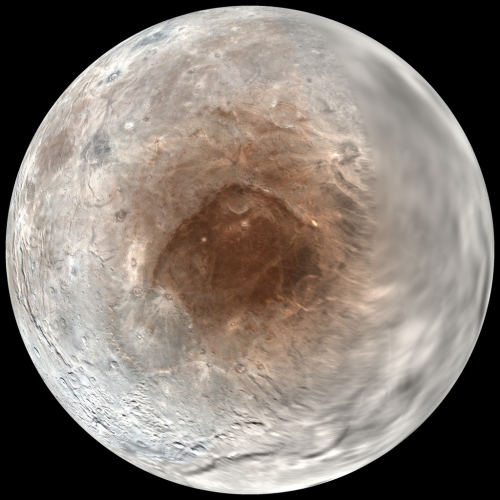
Image: Mosiac of New Horizons MVIC color observations of Charon obtained during the final 6.4 day rotation on approach to the system during July 7-14, shown in polar orthographic projection. Credit: NASA/Johns Hopkins University Applied Physics Laboratory/Southwest Research Institute.
Tholins are complex organic molecules that can be formed when ultraviolet light strikes simple organic molecules like methane. We find the dark red of Charon’s polar cap duplicated on the surface of Pluto in areas where these interactions occur. And as the paper notes, the nearby atmosphere of Pluto provides ‘potential feedstock’ for this complex chemistry at Charon’s pole. Grundy’s team was able to model the surface thermal environment on Charon, capturing the cold-trapping of material from Pluto and its processing into more complex molecules, all consistent with earlier theories but modeled for the first time quantitatively.
New Horizons provided data on the escape rates of methane and nitrogen. The former exists in a frozen state on Charon’s surface only during the polar winter night, which means that it is being processed quickly, although it need not be fully converted into tholins right away, but only into molecules that are non-volatile enough to remain on the surface when the pole is again exposed to sunlight.
As to radiation sources with an impact on Charon’s surface, the paper notes ultraviolet photons, solar wind charged particles, galactic cosmic rays and interstellar pickup ions. The latter result from solar wind protons interacting with neutral hydrogen atoms from the interstellar medium. The paper pegs the most important night-side radiation source as solar ultraviolet photons that have been scattered by the interplanetary medium.
Once the pole is back in sunlight, ultraviolet radiation directly from the Sun can drive further chemistry. Interestingly, we find a reddish spot on the small Plutonian satellite Nix, but the authors argue that it and the other small moons orbit farther from Pluto and have lower masses, which makes the process less efficient. Charon is a different story. With sufficient mass and a winter lasting for over a century, its trapping of Pluto’s methane produces a highly visible result.
The paper is Grundy et al., “The formation of Charon’s red poles from seasonally cold-trapped volatiles,” Nature 15 September 2016 (abstract).

